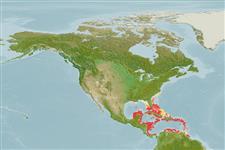Common names from other countries
Classification / Names / Names
Namen | Synonyme | Catalog of Fishes (gen., sp.) | ITIS | CoL | WoRMS
Environment: milieu / climate zone / depth range / distribution range
Ökologie
Riff-verbunden; tiefenbereich 0 - 70 m (Ref. 847). Subtropical; 35°N - 8°N, 92°W - 58°W (Ref. 847)
Western Atlantic: USA to Caribbean Sea.
Length at first maturity / Size / Gewicht / Alter
Maturity: Lm ? range ? - ? cm
Encrusting to submassive colonies. Deep, monocentric corallites with 2-3 centers. Centers are separated by collines of irregular height and which run in irregular directions. Long and short septocostae clearly alternate. Uniform tan or mottled yellow-brown, sometimes with green mouths in color.
Maximum depth from Ref. 83917. Zooxanthellate (Ref. 116012).
Life cycle and mating behavior
Geschlechtsreife | Fortpflanzung | Ablaichen | Eier | Fecundity | Larven
Hermaphroditic (Ref. 113712). Mature gametes are shed into the coelenteron and spawned through the mouth. Life cycle: The zygote develops into a planktonic planula larva. Metamorphosis begins with early morphogenesis of tentacles, septa and pharynx before larval settlement on the aboral end (Ref. 833).
Collin, R., M.C. Díaz, J. Norenburg, R.M. Rocha, J.A. Sánchez, M. Schulze, A. Schwartz and A. Valdés. 2005. (Ref. 415)
IUCN Rote Liste Status (Ref. 130435)
CITES Status (Ref. 108899)
Not Evaluated
Nutzung durch Menschen
| FishSource |
Tools
Mehr Information
Alter/GrößeWachstumLänge-GewichtLänge-LängeMorphologieLarvenDichte
Internet Quellen
Estimates based on models
Preferred temperature
(Ref.
115969): 25.1 - 28.1, mean 27.1 (based on 164 cells).
Preiskategorie
Unknown.
